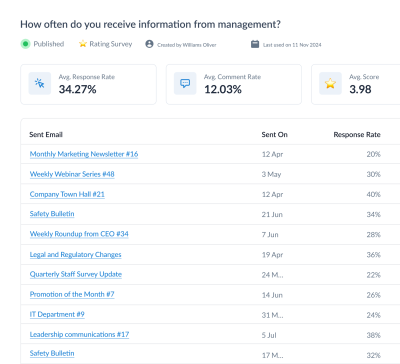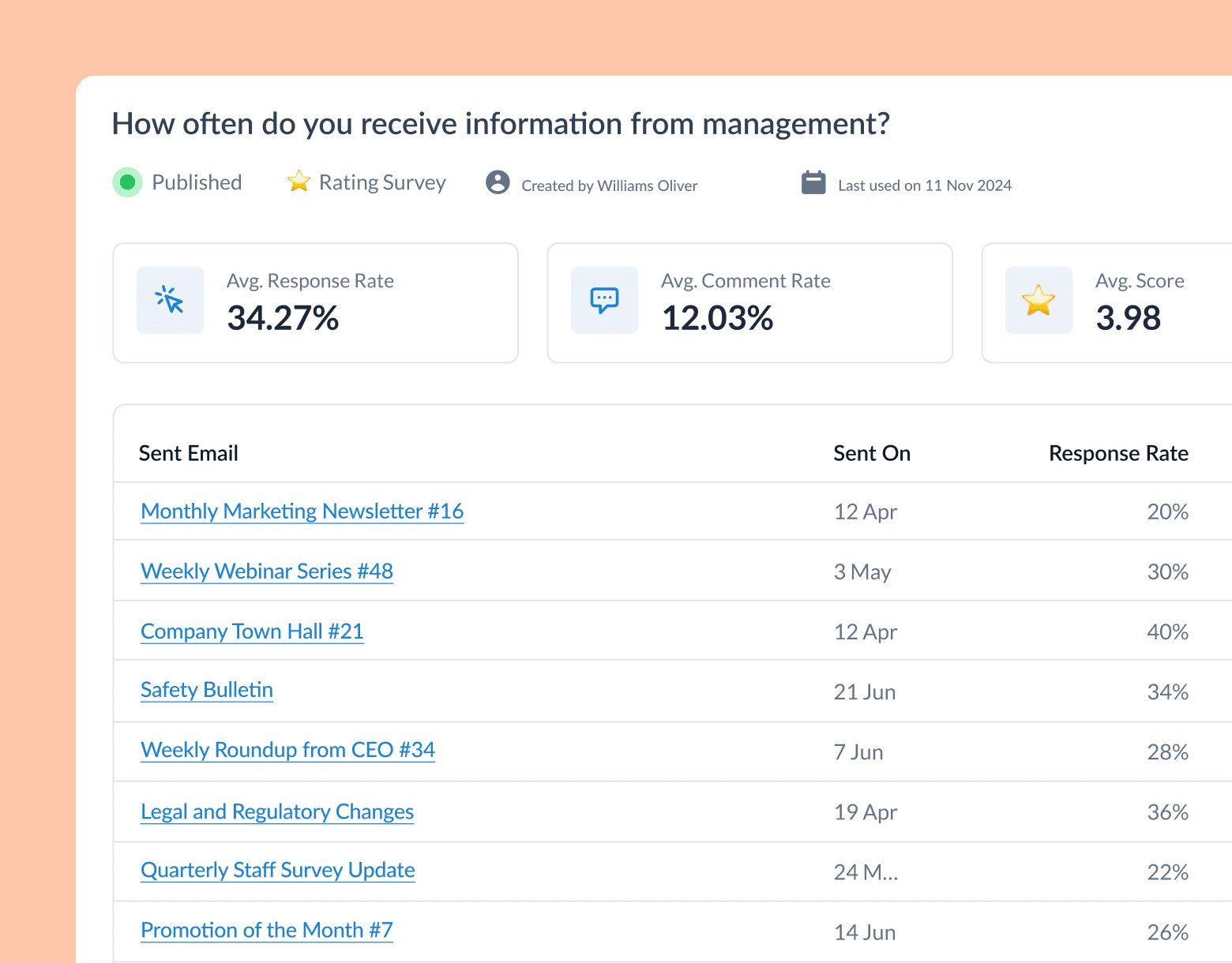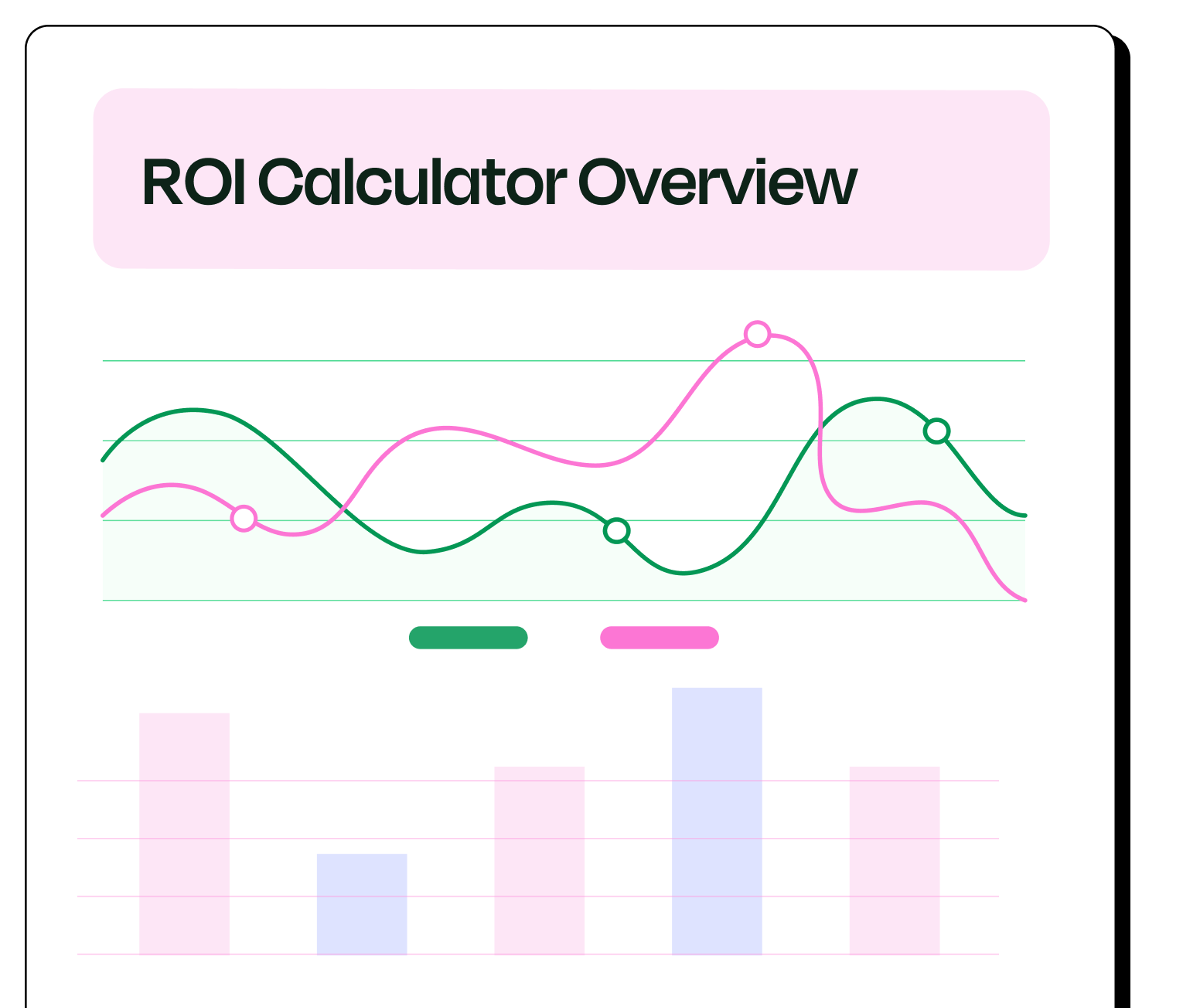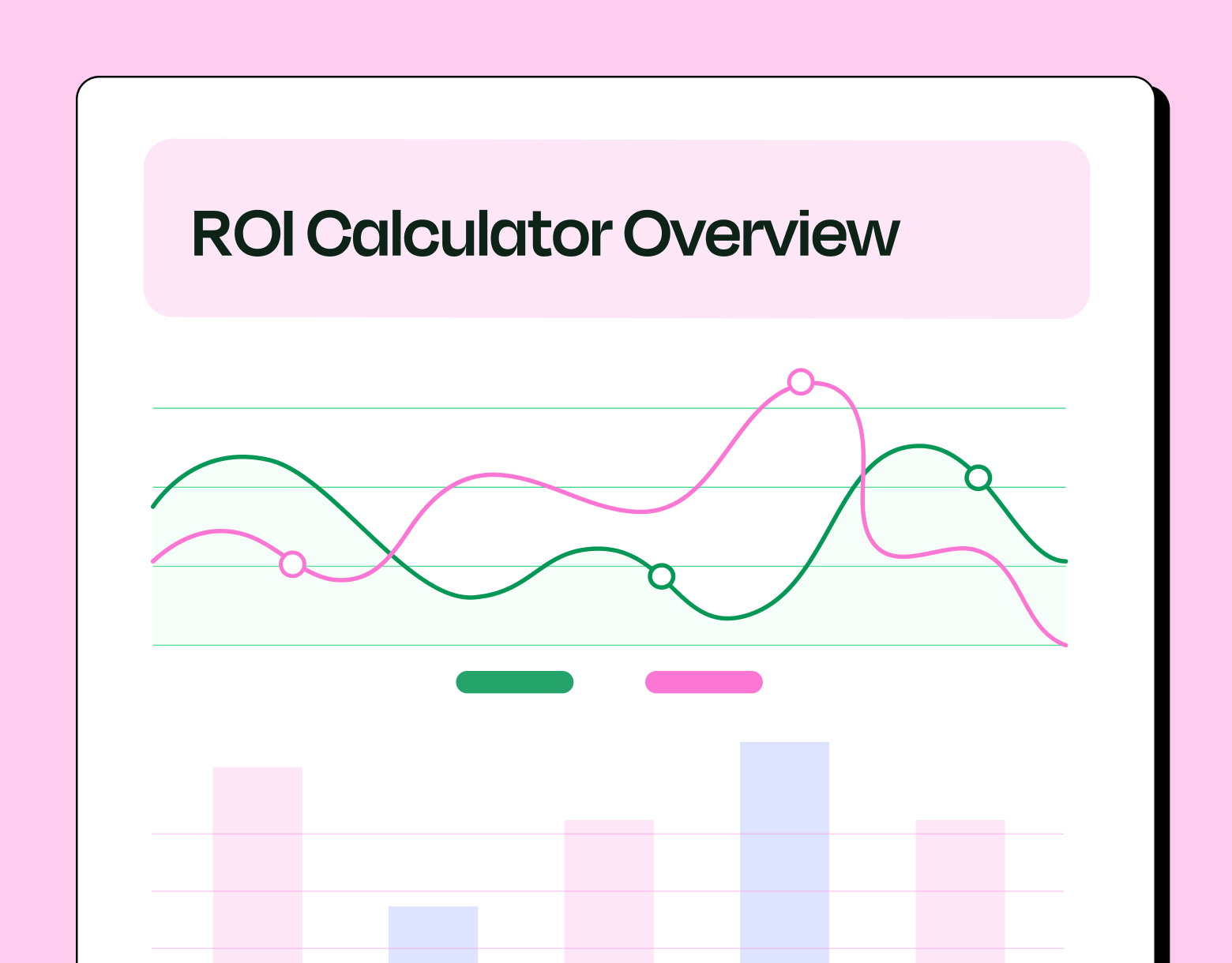Your business revolves around goal-setting. So why should it be any different when it comes to employee engagement? By identifying your employee engagement goals, you can set a clear, time-bound path towards boosting workplace engagement.
Employee engagement goals help guide your business towards success. Yet they’re often overlooked because employers are at a loss when it comes to tracking employee engagement.
Discover our 10 best employee engagement goals that you need to be setting in order to succeed. We’ll also look at what internal communications tools are most likely to improve employee engagement and help you collect employee feedback.
Take a self-guided tour of ContactMonkey
See how our key features can streamline your internal communications.
Take product tour

What Is Employee Engagement?
Employee engagement is a personal and emotional connection that staff experience in relation to their company. It builds a sense of pride and motivation in one’s work while raising employee morale.
In turn, this creates a domino effect that impacts just about every area of your company.
In other words, employee engagement determines everything from how much creativity employees exercise in their tasks, to how long they stay with your company.
Why is employee engagement important?
Think back to the last positive customer service experience you had. Maybe you called to ask about installing software, or a package you ordered from the vendor was delayed.
The reason you thought back to this interaction was likely a helpful and caring employee on the other end.
The moral of the story?
Employee engagement is important because engaged staff go above and beyond in their work and deliver exceptional—and memorable—results. This is just one of the many benefits of engaged employees. And that extends to everything from customer service to business innovation and attention to detail.
Be sure to check out these insights on how to create engaged employees for a productive environment.
Types of Employee Engagement
While you may think that employee engagement only comes in two forms: engaged and disengaged, it’s a bit more complicated than that.
To create effective employee engagement goals, it’s important to understand how to recognize different types of engagement first.
Let’s take a look at the three types of employee engagement:
Actively Engaged: these employees are fully committed to your company’s mission and passionate about its goals. They bring a positive attitude and don’t settle for business as usual—they strive for better. You’ll find these employees volunteering to help others, leading workplace discussions, and sharing new ideas.
Not Engaged: these types of employees are not entirely disengaged—they still show up to work daily, put in the time, and finish their tasks. But if something better comes along, they’ll take off in the blink of an eye. It’s also unlikely that these employees will be passionate about promoting company values or go above and beyond in customer relations.
Actively Disengaged: these team members are often resentful about the company at large and have a negative perception of your company’s employee experience strategy. The discontent of these employees can easily impact your company’s reputation.
Start two-way conversations and employee feedback loops
Learn how to engage staff with pulse surveys, content ratings and reactions, custom polls, and more. Ready to send modern emails?
See engagement features

Drivers of Employee Engagement
It’s easy to blame one employee’s bad attitude or work ethic for employee disengagement. But it’s important for employers to take accountability and recognize that workplace culture and environment have a huge impact.
If you want to turn disengaged employees into engaged ones, you’ll have to foster a work environment and opportunities that help employees thrive.
That’s where the drivers of employee engagement come into the mix.
Employee engagement drivers are different areas and elements of the employee experience that directly impact engagement. These include:
- Leadership
- Company culture
- Compensation and benefits
- Employee recognition
Your employee engagement committee goals should be in alignment with these drivers. Check out our blog post on the top drivers of employee engagement for a full breakdown.
How to Set Employee Engagement Goals
After you have recognized the identified the key focus of your employee engagement program, the time has come to develop your core objectives. Here are some tips to keep in mind:
- Your employee engagement goals should follow the SMART rule. They should be: specific, measurable, attainable, relevant and time-bound.
- You should create organizational internal communications goals that can be distributed into team and departmental objectives. Targets should be precise and include employee engagement metrics.
- If your goal is to increase staff feedback, for instance, then your objective should be to increase responses on your employee surveys by 15% (or your desired percentage).
- Make sure you have a designated team responsible for fulfilling your employee engagement goals, such as an employee engagement committee. This helps keep the process organized and ensure that there is someone accountable for the achievement of your employee engagement goals.
Take a self-guided tour of ContactMonkey
See how our key features can streamline your internal communications.
Take product tour

10 Employee Engagement Goals and Objectives
Your company’s marketing team wouldn’t plan a content calendar without knowing the objectives and employee engagement KPIs guiding it.
In the same vein, you can’t start thinking about activities to improve employee engagement without understanding the goals behind employee engagement.
Below, we break down a few key employee engagement goals to consider when developing your strategy and internal communications plan.
1. Employee alignment with company goals and values
Clarity is one of the biggest drivers of employee engagement. And clarity happens when employees are aligned with company goals and values.
Why? Because staff aren’t confused about the purpose or significance of their work.
They know their efforts are valued and that their contribution is a vital part of your company’s success.
How to reach this goal:
Be crystal clear and compelling when communicating your company goals and values. Use your employee newsletter to spotlight team accomplishments, exciting company news, and anything else that echoes the identity and mission of your brand.
With ContactMonkey’s email template builder, you can customize and personalize your employee newsletter. Set brand guidelines, add slogans, and graphics that reflect your brand.
You can also target your email campaigns to only relevant recipients, which helps drive email engagement and reduces the amount of unnecessary emails your employees receive. Using ContactMonkey’s list management feature, you can create custom email lists to organize your email sends. Create email lists—without needing IT—that integrate with your Human Resource Information System (HRIS) like Workday and ADP, as well as Azure Active Directory, so they’ll update automatically.
2. Employee productivity
When we talk about productive employees, we aren’t simply talking about work machines. We’re talking about staff making a visible impact on your business outputs.
That includes being creative, innovative, passionate, and most of all—engaged in the work.
Productive employees continuously think of new solutions to business problems and go above and beyond in their tasks. The result: not just greater but better business productivity.
How to reach this goal:
With time, a monotonous work routine will exhaust your employees. They’ll lose begin to lose passion for their work. And that’s a one-way street to disengagement and less productivity. To avoid this, conduct regular employee pulse surveys. Ask employees to rate their work environment and give suggestions on what can be improved.
With ContactMonkey’s email template builder, you can embed reactions into any segment of your internal communications. Use emoji reactions, star ratings, thumbs/up down and more.
Unlock Internal Comms Superpowers
Discover why 10,000+ rely on us. See the internal email and employee newsletter platform in action.
Book demo

3. Employee motivation
Employee engagement and employee motivation go hand in hand.
Motivated employees are excited to reach new heights in their careers and are fueled by company achievements. They have a commitment to the organization’s goals and perform better in their roles as a result.
How to reach this goal:
If you want to keep employees motivated, you need to offer inspiration. Give employees more autonomy over a project and consistently recognize employees who excel in their tasks.
Use your virtual town hall to give shoutouts to employees and show your appreciation in front of the whole team. With ContactMonkey’s employee communications app, you can also use your internal newsletter to create dynamic employee of the month features or even send personalized thank you messages.
4. Enhance employee wellbeing
Stressed and exhausted employees aren’t thinking about how to get engaged at work—they just want to make it through the day.
If you want to foster an engaged workforce, employee wellbeing needs to be one of your top employee engagement goals.
How to reach this goal:
Did you know that a significant percentage of employers believe an employee wellbeing program has a significant impact on employee engagement? Determine if your company needs to add employee wellness initiatives by asking staff directly.
Use an employee wellness pulse survey to get employees to rate their current state of wellbeing and offer anonymous suggestions on what can help. With a pulse survey tool that provides guaranteed anonymity employees can answer honestly and authentically.
5. Improve employee safety
Disengaged employees are not too concerned about the success or reputation of your company. They also aren’t interested in sticking to best practices that help them do their job well.
As a result, these employees are not fully vested in safety culture. This leads to countless safety incidents as disengaged employees overlook important safety protocols or use the fast-track route. Be sure to outline important safety procedures in your employee handbook so new employees take them to heart right from the start.
How to reach this goal:
Employee safety is a paramount employee engagement goal. It can only be achieved when employees are invested in your company’s success and have a clear understanding of their role in it.
Begin by focusing on effective communication. Make sure employees are on the same page about safety protocols—understanding what they are and why they matter.
To ensure that employees are receiving and reading vital safety information, use an internal email tracking tool like ContactMonkey. It lets you see who opened your emails on safety procedures, clicked on important resources, and even how long they engaged with it.
You can also use ContactMonkey’s click maps feature to see what parts of your emails grab the attention of your employees. This information can help you optimize your email design to ensure important information gets noticed by your recipients.


6. Align employees and management
A business is made up of many moving parts. But they need to be in sync in order for things to run smoothly.
That’s why alignment between employees and managers is vital. And it has big consequences for employee engagement.
If staff are confused about their assigned tasks, unhappy with their workload, or generally dissatisfied with management, employee engagement is out of the question.
How to reach this goal:
Always ensure employees and managers are on the same page through consistent communication. Establish reliable communication channels while cultivating an environment where feedback is the norm. That includes feedback to managers and employee feedback from managers.
Your employee engagement survey goals should be focused around getting honest and authentic feedback—this will give you a better approach for your future employee engagement ideas. With ContactMonkey’s anonymous pulse surveys, you can turn your internal emails into a two-way communication stream by embedding surveys directly into employee newsletters.Learn more about the benefits of employee engagement surveys. Also, learn how to design an employee engagement survey that can assist in reaching this goal.
7. Reduce employee turnover
You’ll need deep pockets to handle the employee turnover that arises from disengagement. The cost to replace a staff member ranges between 30% and a whopping 400% for senior employees.
By adhering to employee engagement best practices, and having solid employee onboarding procedures, you’ll understand how to improve employee retention and ensure you’re not losing valuable employees alongside taking a hit to your bottom line.
How to reach this goal:
Employees who see a future at their company are more engaged and not as likely to jump ship at the first chance. If you want to reduce employee turnover, boost engagement by offering more professional development opportunities alongside some creative employee recognition ideas.
When employees see the potential for growth at your company, they’re not as likely to leave. Neither are those employees who feel recognized for their efforts and who foresee promotions or bonuses if they keep up their quality of work.
8. Increase customer satisfaction
Remember when we asked you to look back on a positive customer service experience at the start of this post? Then you already know why increased customer satisfaction is a top employee engagement goal.
A universal truth: clients will always be put off by disengaged employees. And it’s no wonder— these employees will rarely go the extra mile to deliver exceptional service.
If you want your clients to believe in your product, you have to ensure that your employees convey trust and enthusiasm for the brand themselves.
How to reach this goal:
Brand reputation and loyalty is built by satisfied customers. This begins with engaging employees through a compelling company vision and values.
This is a long-term commitment, which will require a solid internal marketing strategy. But ultimately, by investing in your employees, they’ll invest right back into your company.
How much is low employee engagement costing you?
Tally it up with ContactMonkey’s ROI calculator.
Calculate now

9. Reduce absenteeism
Actively disengaged employees are those that feel strong dissatisfaction with your company. Truth be told, they’re still hanging on because nothing better came along yet.
In the meantime, they’ll take every opportunity to avoid a workplace where they feel unhappy. The result: a spike in absent or late employees.
How to reach this goal:
To decrease absenteeism, you’re going to have to boost employee engagement. Begin by tracking absenteeism by department and setting goals to improve your metrics.
It’s likely that the business units with high absenteeism have high employee disengagement. And vice versa. With ContactMonkey’s segmented email stats, you can find out exactly where there are problem areas within the company and target them accordingly.
10. Create a culture of high performance
Just like disengagement can have far-reaching effects beyond a single employee, employee engagement is equally contagious.
It impacts every single aspect of your company culture: how staff collaborates with one another, how comfortable they feel sharing ideas, and how they work towards common goals.
How to reach this goal:
Creating a culture of high performance involves just about every employee engagement driver—from employee motivation to alignment with company values.
When employees see that your organization us continuously succeeding, they want to get engaged and be part of that success.
For your part, use every channel at your disposal—from virtual events to your internal company newsletter to advocate and elevate company values.
Set, Track, and Achieve Your Employee Engagement Goals With ContactMonkey
The road to employee engagement is by no means linear. Employee engagement apps can set you on the right track and help you.
A clear intenal employee engagement benchmark is crucial for comparing your team’s engagement levels against industry leaders and setting actionable goals.
With data-driven software for employee engagement like ContactMonkey, you can measure employee engagement from a single platform and easily prove the ROI of employee engagement.
Use ContactMonkey to track where your engagement levels currently stand and see where you’re underperforming. Once you have the insights under your belt, use the email template builder to easily create content that resonates with your staff.




